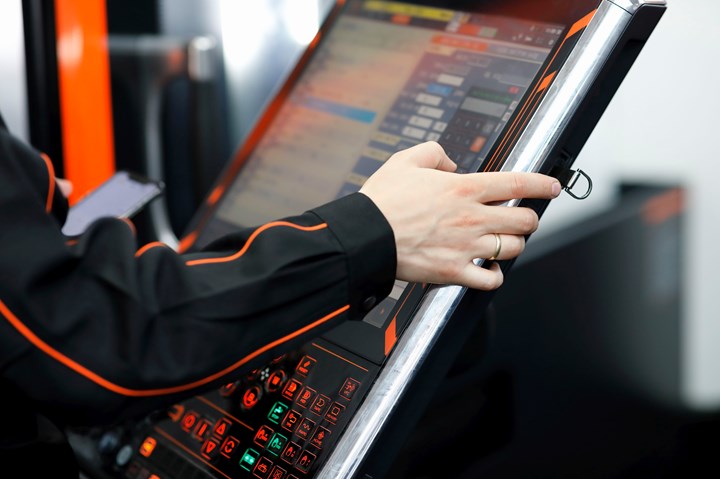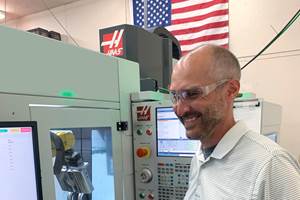3 Examples of Machines that Combine Manufacturing Methods
Certain “hybrid” machines combine some form of additive manufacturing with CNC subtractive manufacturing. Columnist Mike Lynch, President of CNC Concepts Inc., explores three types of these machines here.

Stand-alone machines, be they additive or subtractive in nature, can typically perform a single form of manufacturing. 3D printers can only perform additive manufacturing; CNC milling machines can only perform subtractive manufacturing. Each methodology has shortcomings that are easily overcome by the other.
Component accuracy, repeatability, and surface finish that can be easily achieved by CNC machining cannot be matched by today’s additive manufacturing methods alone. On the other hand, complex component internal geometries (such as cooling channels in injection molds) that are easily achieved with additive processes can be difficult or impossible to achieve with CNC machining.
It is unlikely that improvements in subtractive manufacturing methods will ever fully overcome shortcomings easily handled by additive methods. But the jury is still out on whether additive manufacturing methods will eventually match or even outperform the current advantages of subtractive methods. Indeed, additive technologies are regularly improving while subtractive methods have, for the most part, plateaued.
Regardless, we deal every day with components that require the advantages of both manufacturing methods. To this end, certain “hybrid” machines combine some form of additive manufacturing with CNC subtractive manufacturing processes. I would like to relate the three types of hybrid machines of which I am aware.
The first is not truly a hybrid machine. It is a machine made by Levil Technology and used by educators to teach both manufacturing methods. It can be set up as a CNC milling machine or as a fused filament fabrication (FFF) 3D printer. This will help students learn about CNC machining or 3D printing, one at a time.
The second is truly a hybrid machine, and I believe it is currently the most popular type. It combines laser sintering with CNC machining. One retrofittable option is provided by Hybrid Manufacturing Technologies, though there are others.
Laser sintering in this fashion requires an attachment that incorporates the laser head as well as the material and inert gas flow mechanisms. These can be brought into position automatically, by the automatic tool changer of a machining center or the turret of a turning center. In this sense, the laser sintering device is just another tool the CNC machine can use, albeit a complex one.
Laser sintering in this fashion resembles a welding process. Material is deposited on an empty build surface or an existing workpiece in much the same way a bead is laid down when welding. As with any form of additive, multiple layers are deposited to create the desired shape. Consider for example, building up the individual blades of an impeller.
With present-day methods, laser sintering must still be considered a rough process. Position accuracy and surface finish will not be adequate for most manufacturing specifications. In most cases, at least some surfaces produced by laser sintering must be machined (milled, drilled, etc.) for finishing purposes, which of course, a hybrid machine can perform.
One advantage a CNC-based hybrid machine has over most stand-alone laser sintering machines is related to the number of moving axes. Most stand-alone machines have but three linear axes, while CNC-based hybrids can have additional rotary axes. So, any motion the CNC can make can be incorporated into the laser sintering process. Consider again an impeller. This kind of component may require the use of a 4- or 5-axis machine – for laser sintering and for CNC machining.
If the second type of hybrid machine can be thought of as a CNC machine with laser sintering capabilities, then the third kind is more like a 3D printer that has CNC machining capabilities.
3D printing with this kind of hybrid machine resembles that of any other deposition 3D printer. Instead of laying down layers of heated plastic or infused plastic filament, this particular machine layers with metal infused paste (P20-equivalent and H13 tool steels). The printed component is then sintered to produce a strong metal workpiece that has the characteristics of the same metals produced by conventional methods. The one manufacturer I am aware of that provides a machine using this method is Mantle Inc. I give a synopsis of the process here; next month’s CNC Tech Talk column will provide much more detail.
Mantle’s hybrid process incorporates CNC machining at every step, even before the 3D printing process begins. The removable build plate contains a pocket filled with a proprietary build surface material. The cycle starts with a CNC milling operation that precisely qualifies/flattens the build surface onto which the first layer will be deposited. A vacuum removes machined particles during milling.
Next begins layering the metal-infused paste. After each layer, a heater removes moisture from the paste before the next layer is printed. This improves density and solidifies the material. Additionally, a CNC milling operation flattens the very top of each layer so the next layer can be perfectly deposited. The vacuum again removes machined particles. After every ten layers or so, a milling cutter will smooth the side walls and cut fine features, along with vacuuming. Printed and dried layers – prior to sintering – will have the consistency of a crayon, making them very easy to machine.
The result is an ultra-precise, smooth component that is ready for sintering. Sintering dissolves the build surface material to allow easy component removal and consistent shrinkage. Sintered H13 workpieces commonly have a hardness of 42 on the Rockwell C-scale, a surface finish of 1-3-microns RA, and a predictable accuracy of 0.004-in overall in a 4-in cubic envelope. This means post process-work is minimal or nonexistent.
Again, we will dive deeper into this unique process next month.
Related Content
When Handing Down the Family Machine Shop is as Complex as a Swiss-Turned Part
The transition into Swiss-type machining at Deking Screw Products required more than just a shift in production operations. It required a new mindset and a new way of running the family-owned business. Hardest of all, it required that one generation let go, and allow a new one to step in.
Read More7 CNC Parameters You Should Know
Parameters tell the CNC every little detail about the specific machine tool being used, and how all CNC features and functions are to be utilized.
Read More5 Reasons Why Machine Shop Ownership Is Changing
Mergers, acquisitions and other ownership changes are an effect of Boomer-age shop owners retiring, but only in part. Also important: The way we think about machining has changed.
Read MoreKey CNC Concept No. 1—The Fundamentals Of Computer Numerical Control
Though the thrust of this presentation is to teach you CNC usage, it helps to understand why these sophisticated machines are so important. Here are but a few of the more important benefits offered by CNC equipment.
Read MoreRead Next
The Cut Scene: The Finer Details of Large-Format Machining
Small details and features can have an outsized impact on large parts, such as Barbco’s collapsible utility drill head.
Read More3 Mistakes That Cause CNC Programs to Fail
Despite enhancements to manufacturing technology, there are still issues today that can cause programs to fail. These failures can cause lost time, scrapped parts, damaged machines and even injured operators.
Read More
.jpg;width=70;height=70;mode=crop)












.png;maxWidth=300;quality=90)












